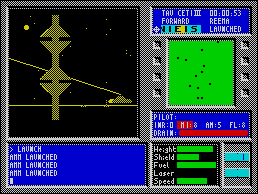|
'A SINGLE skilled pilot might succeed where 50 would surely fail' is never a very convincing reason for taking on the robot might of an entire planet, but when it's a question of re-colonising Tau Ceti for the good of mankind ... sucker, you're it.

For once, it's well worthwhile. CRL has produced a massive space opera in Tau Ceti, combining adventure, zapping, strategy, and excellent graphics in a game of enormous complexity.
You must shut down the fusion reactor in the city of Centralis which runs the robot defences of the entire planet. Collect up the fusion rods, scattered around the planet, and insert them in the main reactor.
Unfortunately, you also have to deal with the automated defences - free moving hunter-killer robots, land mines, and fortress towers bristling with lasers. Those are depicted in wireframe graphics on a window to the left of the screen, and vary depending on the time of day and how well your scanner is working.
Most of the action takes place in flight mode, as you explore the various cities looking for repair depots and reactor sub-stations - where fragments of rod can be found. When you dock with one of those havens, you enter ground mode. Text input generates a number of options, including a map of the planet which can be magnified, and a library of information on each city. The rods themselves are manipulated at this stage. Initially you only receive fragments, and they must be assembled like a jigsaw puzzle.

Movement between cities - there are at least two dozen - is by using pre-programmed jump pads, which link you to specific cities. Since cities have differing levels of defences, working out sensible routes to collect all the rods is of prime importance.
The right-hand side displays a radar system giving advance warning of objects, and two targeting displays, one indicating the direction of the city centre, vital for aligning yourself with jump pads, and the other showing your base. Add to that a notepad facility for keeping track of what you've done, save and load features, and plenty of status displays for your craft, and there's not a lot left you could want.
The various buildings and nasties have carefully defined shapes, outlined in the instructions, but from a distance they look very alike. Particularly confusing are the craters, which look just like jump pads, but without a thin pole next to them.
Such a vast structure could easily become boring and muddled, but in spite of all the options the game is easy to play and hard to beat. Best of all, the scenario becomes quite convincing after a while, with real desperation setting in as the shields run out, and deepening sense of panic helped by the quality of the wireframe graphics.
It's hard to imagine a better space game, unless one's talking about Elite, with its intergalactic scope and strategic depth. Viewed as a shoot 'em up with a purpose to the carnage, Tau Ceti has to be one of the all-time greats.
Publisher CRL Price £9.95
Memory 48K Joystick Redefinable keys
***** |
|
| Chris Bourne |
|